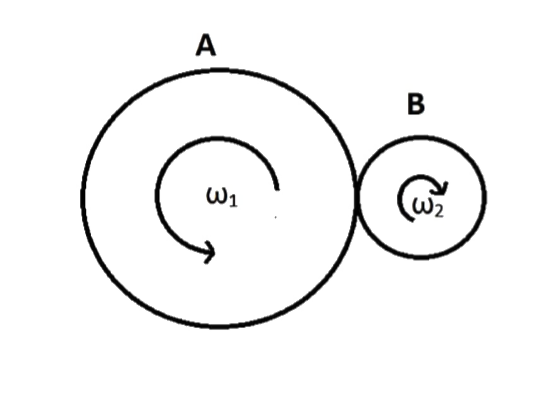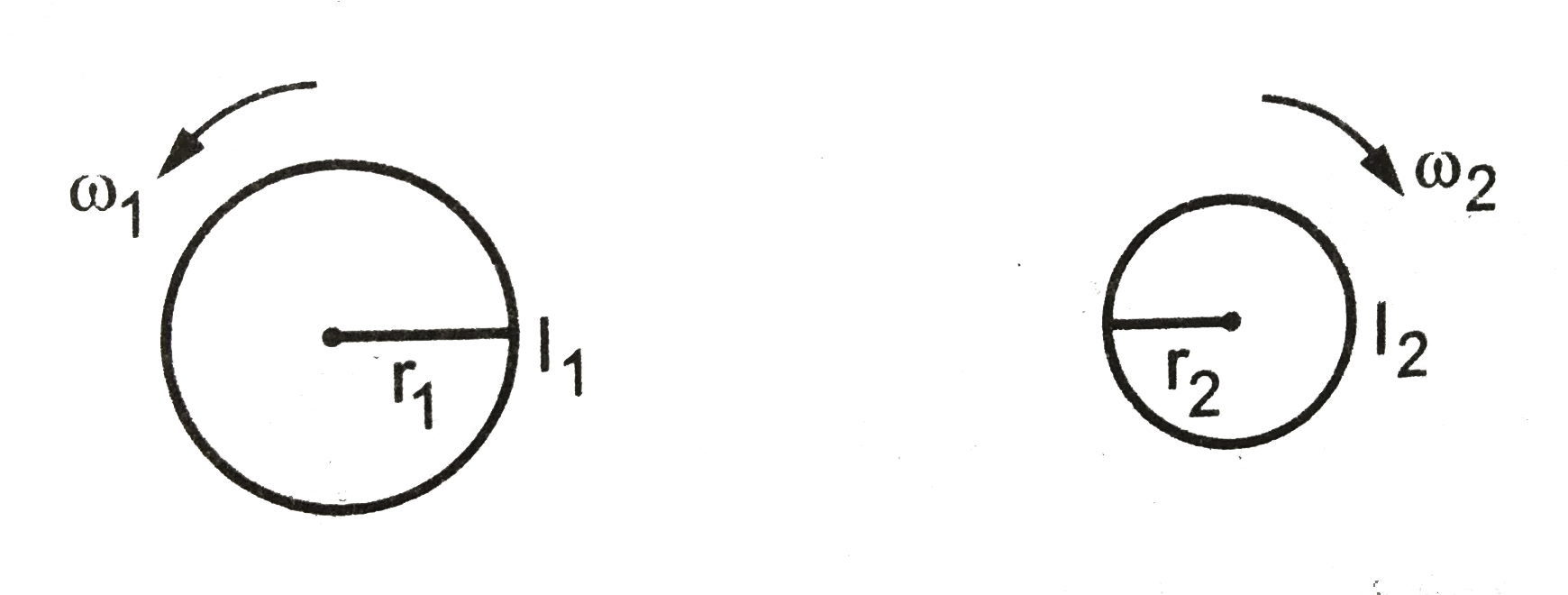Two discs of moments of inertia I1 and I2 about their respective axes , rotating with angular frequencies ω1 and ω2 respectively, are brought into contact face to face with their axes of rotation coincident. The angular frequency of the composite disc will be
a. I1ω1+I1ω2I1+I2
b. I2ω1+I1ω2I1+I2
c. I1ω1−I2ω2I1−I2
d. I2ω1−I1ω2I1−I2
The correct Answer is:a
To solve the problem of finding the angular frequency of the composite disc formed by two discs with given moments of inertia and angular frequencies, we can follow these steps:
1. Define the Given Quantities:
- Let the moments of inertia of the two discs be I1 and I2.
- Let the angular frequencies of the two discs be ω1 and ω2.
2. Calculate the Initial Angular Momentum:
- The total initial angular momentum Linitial of the system before the discs are brought into contact can be expressed as:
Linitial=I1ω1+I2ω2
3. Determine the Moment of Inertia of the Composite Disc:
- When the two discs are brought into contact, they rotate together as a single composite disc. The total moment of inertia Itotal of the composite disc is the sum of the individual moments of inertia:
Itotal=I1+I2
4. Apply the Conservation of Angular Momentum:
- According to the principle of conservation of angular momentum, the total initial angular momentum must equal the total final angular momentum after the discs are joined:
Linitial=Lfinal
- The final angular momentum Lfinal can be expressed as:
Lfinal=Itotal⋅ω
- Therefore, we have:
I1ω1+I2ω2=(I1+I2)⋅ω
5. Solve for the Final Angular Frequency ω:
- Rearranging the equation to solve for ω:
ω=I1ω1+I2ω2I1+I2
6. Final Result:
- The angular frequency of the composite disc is given by:
ω=I1ω1+I2ω2I1+I2
- Let the moments of inertia of the two discs be I1 and I2.
- Let the angular frequencies of the two discs be ω1 and ω2.
- The total initial angular momentum Linitial of the system before the discs are brought into contact can be expressed as:
Linitial=I1ω1+I2ω2
- When the two discs are brought into contact, they rotate together as a single composite disc. The total moment of inertia Itotal of the composite disc is the sum of the individual moments of inertia:
Itotal=I1+I2
- According to the principle of conservation of angular momentum, the total initial angular momentum must equal the total final angular momentum after the discs are joined:
Linitial=Lfinal
- The final angular momentum Lfinal can be expressed as:
Lfinal=Itotal⋅ω
- Therefore, we have:
I1ω1+I2ω2=(I1+I2)⋅ω
- Rearranging the equation to solve for ω:
ω=I1ω1+I2ω2I1+I2
- The angular frequency of the composite disc is given by:
ω=I1ω1+I2ω2I1+I2
Topper's Solved these Questions
- SYSTEM OF PARTICLES AND ROTATIONAL MOTIONSBOOK - NCERT FINGERTPS ENGLISHCHAPTER - SYSTEM OF PARTICLES AND ROTATIONAL MOTIONSEXERCISE - ROLLING MOTION
16 Videos
- SYSTEM OF PARTICLES AND ROTATIONAL MOTIONSBOOK - NCERT FINGERTPS ENGLISHCHAPTER - SYSTEM OF PARTICLES AND ROTATIONAL MOTIONSEXERCISE - HOTS HIGHER ORDER THINKING SKILL
8 Videos
- SYSTEM OF PARTICLES AND ROTATIONAL MOTIONSBOOK - NCERT FINGERTPS ENGLISHCHAPTER - SYSTEM OF PARTICLES AND ROTATIONAL MOTIONSEXERCISE - DYNAMICS OF ROTATIONAL MOTION ABOUT A FIXED AXIS
10 Videos
- PRACTICE PAPERSBOOK - NCERT FINGERTPS ENGLISHCHAPTER - PRACTICE PAPERSEXERCISE - All Questions
150 Videos
- THERMAL PROPERTIES OF MATTERBOOK - NCERT FINGERTPS ENGLISHCHAPTER - THERMAL PROPERTIES OF MATTEREXERCISE - Assertion And Reason
10 Videos
Similar Questions
Two discs of moments of inertia I1andI2 about their respective axes (normal to the disc and passing through the centre), and rotating with angular speed ω1andω2 are brought into contact face to face with their axes of rotation coincident . What is the angular speed of the two-disc system ?
View SolutionTwo discs, each having moment of inertia 5kgm2. about its central axis, rotating with speeds 10rads−1 and 20rads−1, are brought in contact face to face with their axes of rotation coincided. The loss of kinetic energy in the process is
View Solution
Knowledge Check
Two discs of moments of inertia I1 and I2 about their respective axes (normal to the disc and passing through the centre), and rotating with angular speed ω1 and ω2 are brought into contact face to face with their axes of rotation coincident. What is the loss in kinetic energy of the system in the process?
AI1I2(ω1−ω2)22(I1+I2)BI1I2(ω1−ω2)22(I1+I2)CI1I2(ω1+ω2)2I1−I2DI1I2(ω1+ω2)22(I1−I2)
Two discs of same moment of inertia rotating their regular axis passing through centre and perpendicular to the plane of disc with angular velocities ω1 and ω2. They are brought into contact face to the face coinciding the axis of rotation. The expression for loss of enregy during this process is :
View SolutionTwo discs of same moment of inertia rotating about their regular axis passing through centre and perpendicular to the plane of disc with angular velocities ω1 and ω2. They are brought into contact face to face coinciding the axis of rotation. The expression for loss of energy during this process is
View SolutionTwo uniform circular rough disc of moment of inertia I1 and I12 are rotating with angular velocity ω1 and ω12 respectively in same direction. Now one disc is placed the other disc co-axially. The change in kinetic energy of the system is :
View SolutionTwo coaxial discs, having moments of inertie I1 and I12 are rotating with respective angular volecities ω1 and ω12, about their common axis.They are brought in contact with each other and thereafter they rotate with a common angular volecity.If Ef and Ei are the final and initial total energies, then (Ef−E1) is:
View SolutionTwo bodies with moment of inertia I1 and I2(I1>I2) have equal angular momenta. If their kinetic energy of rotation are E1 and E2 respectively, then.
View SolutionTwo discs A and B are in contact and rotating with angular velocity with angular velocities ω1andω2 respectively as shown. If there is no slipping between the discs, then

View SolutionFigure shows two cylinders of radii r1andr2 having moments of inertia I1andI2 about their respective axes. Initially the cylinders rotate about their axes with angular speed ω1andω2 as shown in the figure. The cylinders are moved closer to touch each other keeping the axes parallel. The cylinders first slip over each other at the contact but the slipping finally ceases due to the friction between them. Find the angular speeds of the cylinders after the slipping ceases.

View Solution
